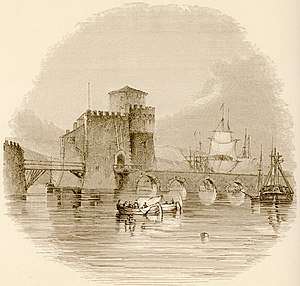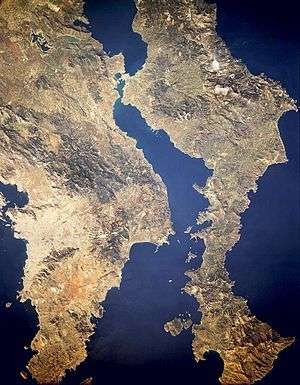Euripus Strait
The Euripus Strait (Greek: Εύριπος[1] [ˈevripos]) is a narrow channel of water separating the Greek island of Euboea in the Aegean Sea from Boeotia in mainland Greece. The strait's principal port is Chalcis on Euboea, located at the strait's narrowest point.
The strait is subject to strong tidal currents which reverse direction approximately four times a day. Tidal flows are very weak in the Eastern Mediterranean, but the strait is a remarkable exception. Water flow peaks at about 12 kilometres per hour (7.5 mph; 6.5 kn), either northwards or southwards, and lesser vessels are often incapable of sailing against it. When nearing flow reversal, sailing is even more precarious because of vortex formation.
The Swiss scholar François-Alphonse Forel contributed to an understanding of the enigmatic phenomenon by his study of limnology and the discovery of seiche, where layers of water of differing temperature oscillate in thickness in a confined body of water. But the problem was solved completely only by D. Eginitis, director of the Athens Observatory, who published his conclusions in 1929.[2]
Bridges
There are two road bridges across the strait, both at Chalcis. One is the Euripus Bridge or Chalcis Bridge, a two-pylon, cable-suspended bridge built south of town in 1992, and commonly called the "New" or "High" bridge, with a span of about 215 m (705 ft). The strait is 160 m (525 ft) wide at this point. The bridge is accessible via a fork on the main road at Aulis.
The "Old" or "Low" or "Sliding" Bridge lies across midtown, and can slide away to allow shipping traffic. It is located at the narrowest point of the strait, where it is only 38 m (125 ft) wide. It accommodates two lanes of vehicular traffic. It was originally built as a retractable bridge in 1858, replaced by a rotating one in 1896. The existing, originally wooden bridge was built in 1962 and was extensively refurbished in 1998.
History
The current consensus is that the Euripus was closed by a dike of coarse sediment until about 6000 years ago.[3] It was opened following an (unrecorded) earthquake and remained open (see Herodotus, e.a. VII.173 and VIII.66, on the sea-battle of Artemision) until 411 BC, when the Euboeans decided to renounce their status as an island subject to Athenian hegemony and make themselves part of Boeotia (Diodorus Siculus, Bibliotheca Historica, 13.47, sections 1–8). There is no trace of this either in Thucydides or in Xenophon (in History of the Peloponnesian War and in Hellenica respectively.) Diodorus mentions specifically that gaps had to be left in the dike to allow the Euripus tides to flow through and that the current became much more intense owing to the narrowness of the passage and says that a single passage was left just wide enough for a single ship. Strabo (IX.2.2) wrote of some later time when there was a bridge two plethra long (approximately 50 m, which is probably an exaggeration). Some vestiges of the two ends of the dike of 411 probably remained, so that this later bridge was probably narrower than the channel that existed before 411 BC. We have no information about the depth, but even in the case of a channel about 50 m wide under Strabo's bridge, the depth could have been scoured out to a level entirely sufficient for ancient shipping.
It is not until the time of the Emperor Justinian I, that we have evidence of two channels in the Euripus, the large original channel and a new, narrow cleft to the east of it, so narrow that it could be crossed on a plank of wood. (Procopius, On the Buildings, 4.3.16.) This later stream is what was eventually widened to make the present shipping channel. At the time when Procopius wrote, the name of the fortress on the Euripus was probably "Euripus," which had become "Egripos" by 1204, and was adopted and slightly altered to "Nigriponte" by the Latins who occupied the place in 1205. (The name has nothing to do with any sort of "Black Bridge," except as a Veronese or Venetian joke, or folk-etymological corruption or re-interpretation in reference to the old bridge across the channel.)

In 1395, Nicola di Martoni came to Negropont during the return from his pilgrimage to Egypt and Palestine.[4] He is clear that the main shipping channel in the Venetian period was on the side of the Boeotian mainland, and mentions the mills on the narrower channel, which he says were sometimes broken in the speed and turbulence of the flow there.
We have further information about the shipping channel and its single wooden bridge from various documents in the archives of the Venetian Empire. In 1408, the formation of a reef under the bridge severely affected shipping (http://www.archiviodistatovenezia.it/divenire/collezioni.htm Senato, Deliberazioni, Misti. 48,43v) and in 1439 there was concern over the tendency of the current to erode the surroundings of the pilings that supported the bridge (http://www.archiviodistatovenezia.it/divenire/collezioni.htm Senato, Deliberazioni, Misti. 60,140r–42r).[5]
Evliya Çelebi, in his Travel Journal (SN VIII250a27, ff.), tells us that the narrow channel was first opened out enough for a galley to pass through at some time in the late 16th century, and was still just barely wide enough at the time of his visit in 1668 for a galley to squeeze through, even though the old shipping channel had been abandoned. By the end of the 18th century it was well on its way to being the width of the modern channel.
See also
Notes
- From Ancient Greek Εὔριπος; R. S. P. Beekes has rejected previous Indo-European derivations and suggested a Pre-Greek one (Etymological Dictionary of Greek, Brill, 2009, p. 482).
- Eginitis, D. (1929). "The problem of the tide of Euripus". Astronomische Nachrichten. 236: 321–328. Bibcode:1929AN....236..321E. doi:10.1002/asna.19292361904. See also the commentary about this explanation in Lagrange, E. (1930). "Les marées de l'Euripe". Ciel et Terre (Bulletin of the Société Belge d'Astronomie). 46: 66–69. Bibcode:1930C&T....46...66L.
- Kambouroglou, Evangelos, Hampik Maroukian, Adamantios Sampson, "Coastal Evolution North and South of Khalkis (Euboea) in the last 5000 Years," Archaeology of Coastal Changes: Proceedings of the First International Symposium "Cities on the Sea—Past and Present" (BAR International Series 404) 1988. Pp. 71–79.
- Leon Legrand, ed. "Relation du pélerinage à Jérusalem de Nicolas de Martoni, notaire italien," Revue de l'Orient Latin 3: (1895) 566–669, (564–55); recently reedited in Studium Biblicum Francescanum, Collectio Major, 42)
- Transcripts in C. Sathas, Mnēmeia Hellēnikēs historias = Documents inédits relatifs à l'histoire de la Grèce au Moyen Âge publiés sous les auspices del la Chambre des députés de Grèce, 2.215 and 3.454, respectively.
References
- Diodorus Siculus, Bibliotheca Historica, 13.47.
- Kambouroglou, Evangelos, Hampik Maroukian, Adamantios Sampson, "Coastal Evolution North and South of Khalkis (Euboea) in the last 5000 Years," Archaeology of Coastal Changes: Proceedings of the First International Symposium "Cities on the Sea—Past and Present" (BAR International Series 404) 1988. Pp. 71–79.
- Leon Legrand, ed. "Relation du pélerinage à Jérusalem de Nicolas de Martoni, notaire italien," Revue de l'Orient Latin 3: (1895) 566–669, (564–55); recently reedited in Studium Biblicum Francescanum, Collectio Major, 42.),
- Procopius, On the buildings of Justinian, 4.3.16.
External links

